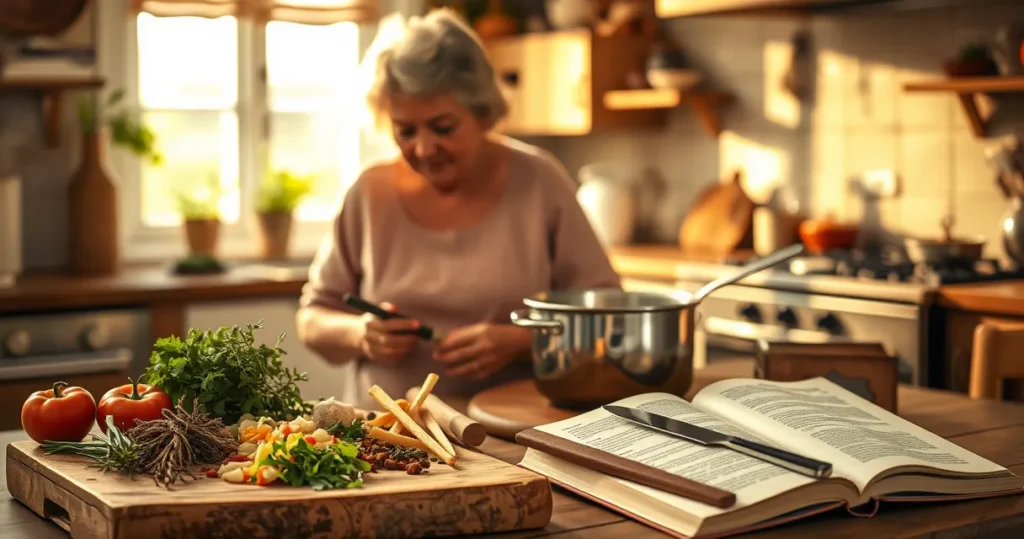Table of Contents
Stewing chicken is a skill that makes ordinary chicken into a delicious dish. It’s cooked slowly to bring out deep flavors. This method makes the chicken so tender, it falls off the bone.
Getting into slow-cooked chicken opens up a world of tasty meals. Stewing chicken needs patience and the right techniques. It creates a dish that everyone will love.
Key Takeaways
- Stewing chicken transforms tough meat into tender, flavorful dishes
- Slow cooking allows for deep flavor development
- Dark meat cuts work best for stewing
- Proper browning is key for rich taste
- Total cooking time typically ranges from 90-95 minutes
- Serves 4-6 people with approximately 508 calories per serving
Understanding the Art of Stewing Chicken
Chicken stewing techniques make simple meals into amazing dishes. It involves cooking chicken slowly in liquid. This makes the chicken tender and full of flavor.

Stewing is more than just cooking. It’s a way to create delicious meals. Slow cooking brings out rich flavors and tender textures that other methods can’t.
Exploring Cooking Method Differences
Stewing is different from quick methods like frying or grilling. The main differences are:
- Longer cooking times at lower temperatures
- Consistent liquid immersion
- Enhanced meat tenderness
- Deeper flavor integration
Advantages of Slow-Cooking Chicken
Slow cooking has many benefits. It breaks down tough fibers, making the meat tender and juicy.
Why Dark Meat Reigns Supreme
Dark meat chicken is the best for stewing. It has more fat and flavor. Chicken thighs and drumsticks stay moist and flavorful even after long cooking times.
Professional chefs love dark meat for stews. They say it keeps moisture and develops deep flavors during slow cooking.
Essential Equipment and Kitchen Tools
Choosing the right stewing equipment can make your chicken stew amazing. Professional home cooks see kitchen tools as essential, not just extras. They help make meals delicious and tender.
When you’re ready to stew chicken, you’ll need some important kitchen items:
- A heavy-bottomed Dutch oven for even heat
- Sturdy wooden spoons for stirring
- A reliable meat thermometer
- Sharp chef’s knife (8 inches recommended)
- Large cutting board
The Dutch oven is key for stewing chicken. It should be cast iron or enameled, lasting up to 500°F. Staub is a top choice for its heat retention, ensuring your stew cooks well.
A meat thermometer is also a must. The Thermapen ONE gives quick, accurate readings. This helps you cook chicken perfectly every time. Kitchen tools for chicken stew are about making food delicious and consistent.
Here are more tools you’ll need:
- Measuring spoons (under $15)
- Large 12-quart stockpot
- Oven thermometer for temperature checks
- Silicone spatulas for high-heat cooking
Quality stewing equipment makes your chicken dishes tender, flavorful, and perfectly cooked.
Selecting the Best Cuts for Stewing Chicken
Choosing the right chicken cuts is key for a tasty stew. Not all chicken parts are good for slow-cooking.
Dark meat chicken is the best for stewing. It’s full of flavor and stays juicy even after long cooking times. Let’s look at the top chicken cuts for stewing.
Thighs vs. Drumsticks: A Flavorful Showdown
Both thighs and drumsticks are great for stewing:
- Chicken thighs are high in fat, making them tender
- Drumsticks have a strong flavor perfect for stews
- Both have connective tissue that softens in slow cooking
Quality Chicken Selection Guide
Choosing quality chicken for stew involves a few things:
- Choose meat with little discoloration
- It should be firm but not too wet
- Fresh chicken should be pinkish-white in color
Fresh vs. Frozen Chicken Considerations
Your choice of chicken affects stew quality. Fresh chicken usually tastes better and feels softer. Frozen chicken works well if thawed and dried right.
Pro tip: If using frozen chicken, thaw it fully and pat it dry before cooking. This keeps the meat at its best.
Preparing Your Ingredients for the Perfect Stew
Chicken stew prep starts with picking the right ingredients and preparing them well. It’s important to gather all your ingredients and set up your workspace. This careful preparation makes a big difference in your meal’s taste and quality.
Choosing the right chicken is key. For a great stew, use bone-in, skin-on chicken thighs and drumsticks. They should weigh about 1.5 kg (3 lbs). Make sure to trim off any extra fat to avoid greasy stew and to get clean, rich flavors.
- Select 6-8 chicken pieces
- Remove unnecessary fat
- Pat chicken dry with paper towels
- Season with salt and pepper
Vegetable prep is also vital for a tasty chicken stew. Cut your veggies evenly so they cook the same. Your veggie mix should include:
- Onions: Finely chopped
- Garlic: Minced
- Carrots: Cut into 1.5 cm thick pieces
- Celery: Chopped into 2 cm chunks
- Baby potatoes: Halved or quartered
Here’s a pro tip: Organize all your ingredients before you start cooking. This mise en place method makes cooking smoother. It helps you keep track of timing and flavor balance.
The Role of Aromatics and Vegetables
Creating a delicious chicken stew starts with understanding the power of aromatics and vegetables. These ingredients are the secret weapons that transform a simple dish into a flavor-packed meal. The right combination of stew vegetables and herbs can elevate your chicken stew from ordinary to extraordinary.
Classic Mirepoix: The Flavor Foundation
The classic mirepoix is the cornerstone of many chicken stews. This traditional combination includes:
- Onions (2 parts)
- Carrots (1 part)
- Celery (1 part)
When you gently cook these aromatics for chicken stew, they release deep, complex flavors. These flavors create a rich base for your dish. Chefs recommend sweating these vegetables in butter or oil for up to 15 minutes to maximize their sweetness.
Expanding Your Vegetable Palette
While the classic mirepoix is excellent, don’t limit yourself. Consider adding these vegetables to your stew:
- Leeks for a mild, sweet flavor
- Fennel for a subtle anise note
- Bell peppers for additional depth
Herbs and Spices for Stewing Success
Your herbs and spices for stewing can make or break the dish. Fresh herbs like thyme, rosemary, and parsley can add incredible aromatic complexity. A few key spices such as bay leaves, black pepper, and paprika can transform your chicken stew into a memorable meal.
Experiment with different combinations to find your perfect flavor profile. Remember, the goal is to create a harmonious blend that complements the chicken and vegetables.
Creating the Perfect Gravy Base
Making the perfect chicken stew gravy is an art. It starts with knowing the basic parts that turn a simple liquid into a tasty sauce.
For a top-notch chicken stew gravy, you’ll need:
- 2 cups low-sodium chicken broth
- 1 chicken bouillon cube
- 1 teaspoon low-sodium soy sauce
- Herb blend: thyme and sage
The trick to a smooth gravy is using the right thickening method. Chefs say a cornstarch slurry is better than roux. It avoids lumps and makes the gravy silky.
To make your stew base, mix 1/4 cup cold water with 3 tablespoons of cornstarch. Stir it into your boiling broth until it’s just right. Adding a bit of cold butter makes the gravy richer and shinier.
Here are some tips to make your chicken stew gravy even better:
- Use fresh herbs for depth
- Season gradually
- Taste and adjust before serving
A great gravy can turn your chicken stew into something amazing.
Mastering the Browning Technique
Browning chicken for stew is key to making a dish special. It creates deep, rich flavors through a chemical reaction called the Maillard reaction. By mastering searing techniques, you can take your chicken stew to the next level.
Temperature control is the key to perfect browning. Follow these steps for a beautiful golden crust:
- Use a heavy-bottomed pan for even heat
- Pat chicken dry before searing to remove moisture
- Heat oil until it shimmers but doesn’t smoke
- Work in small batches to prevent overcrowding
Developing Rich Flavors Through Searing
The right searing technique cooks chicken for 3-4 minutes per side. Aim for a deep golden-brown color to lock in juices. This creates a flavorful fond at the bottom of your pan.
Managing Temperature Control
Proper temperature control is vital when browning chicken. Keep the heat at medium-high, around 400°F (200°C). This ensures a crisp exterior and a tender inside. Be careful not to burn the chicken, as it can make the stew bitter.
Pro tip: Use tongs to turn chicken pieces for an even sear. The goal is a beautiful golden-brown crust that seals in flavor and makes a delicious base for your stew.
The Art of Slow Cooking Times and Temperatures
Mastering slow cooking chicken is all about finding the right balance of time and temperature. It’s a journey of patience and precision. This method turns tough chicken into tender, flavorful dishes that wow anyone.
Experts say to keep the stewing temperature around 160°C (350°F). This low heat helps the chicken cook slowly. It releases rich flavors and makes the meat tender. Cooking time varies, usually between 6 to 8 hours, based on the chicken’s cut and amount.
- Whole chicken: 6-8 hours on low setting
- Chicken pieces: 4-6 hours on low setting
- Chicken breasts: 4-6 hours on low setting
Your slow cooking technique should focus on several critical factors:
- Consistent temperature control
- Proper liquid levels (1-2 cm up the side of the cooking vessel)
- Ensuring internal chicken temperature reaches 75°C for food safety
Pro tip: Always check your chicken’s internal temperature to guarantee it’s cooked perfectly. A meat thermometer is your best friend in achieving delicious, safe slow-cooked chicken every time.
Achieving Tender and Juicy Results
To make a tender chicken stew, you need to be precise and know your cooking techniques. The difference between a tough meal and a juicy dish comes down to preparation and watching the cooking process closely.
Getting juicy stewed chicken is all about paying attention to a few important things. Your aim is to make the chicken so tender it just melts in your mouth. This will make everyone want more.
Testing for Doneness
Figuring out when your chicken is cooked just right involves a few steps:
- Use a meat thermometer to check internal temperature
- Ensure chicken reaches 165°F (74°C) for safe consumption
- Check that meat easily pulls away from the bone
- Look for clear juices when piercing the thickest part
Troubleshooting Chicken Stew Challenges
Having trouble with your chicken stew? Here are some fixes for common problems:
- Tough Meat: Reduce heat and cook longer at lower temperatures
- Dry Chicken: Add more liquid and cover while simmering
- Lack of Flavor: Enhance with additional herbs and spices
Professional chefs say to take chicken out of the fridge 20 minutes before cooking. This helps it cook evenly. By following these tips, you’ll make your tender chicken stew truly special.
Storage and Reheating Guidelines
Storing chicken stew right is key to keeping its taste and ensuring safety. After making a tasty stew, knowing how to store and reheat it is important. This way, you can enjoy leftovers without losing flavor or quality.
Here are the main steps for storing chicken stew:
- Cool the stew quickly before refrigerating
- Use airtight containers for storage
- Refrigerate within 2 hours of cooking
- Store in the refrigerator for up to 3-5 days
- Freeze for extended storage up to 3 months
To reheat stewed chicken, use gentle methods. This keeps the meat tender and prevents it from getting tough. First, thaw frozen stew in the fridge overnight. Then, reheat it on the stovetop over low heat, stirring now and then.
Here are some tips for reheating stewed chicken:
- Use low to medium heat
- Add a splash of chicken broth to keep it moist
- Stir often to avoid burning
- Heat until the internal temperature hits 165°F
Safety tip: Always throw away chicken stew that’s been at room temperature for over 2 hours to avoid food poisoning.
Serving Suggestions and Accompaniments
Make your chicken stew meal special with the right side dishes. These can turn a simple dish into a memorable experience. Choose sides that match the flavors of your stew.
Classic chicken stew sides include:
- Creamy mashed potatoes
- Crusty artisan bread
- Fluffy white rice
- Buttered egg noodles
- Roasted seasonal vegetables
Think about textures and flavors when picking sides. Lighter vegetable sides can offer a nice contrast to the rich stew. A crisp green salad or steamed asparagus can refresh your taste buds and add nutrients.
It’s important to have a variety of nutrients in your meal. Here are some low-calorie options:
- Lemon-Pepper Broccoli (84 calories per cup)
- Warm Tasty Greens with Garlic (137 calories per serving)
- Shredded Gingered Brussels Sprouts (56 calories per serving)
For a complete meal, choose a side that soaks up the stew’s gravy. Rice pilaf or herbed couscous are great choices. They average 166 calories per serving and soak up all the flavors.
Conclusion
Mastering chicken stew requires patience and practice. It also needs a good understanding of cooking basics. By following the tips in this guide, you can create amazing meals that impress everyone.
Choosing the right chicken cuts is the first step. You also need to know about cooking temperatures and adding rich flavors. The techniques you’ve learned will help you make tender, healthy dishes. These dishes will show off your cooking skills and creativity.
Every great stew has a story behind it, full of technique and passion. Whether you’re making a big batch for eight or a smaller one, the basics stay the same. Try new ingredients, mix different seasonings, and make the recipe your own.
Now, with these techniques, you’re ready to make delicious, comforting meals. These meals will become special family recipes for many years.
FAQ
What is the difference between stewing and other cooking methods like roasting or frying?
Stewing cooks chicken slowly in liquid at a low temperature. This method makes the chicken tender and flavorful. Unlike roasting or frying, stewing breaks down collagen and develops rich flavors over time.
Why are dark meat chicken cuts like thighs and drumsticks better for stewing?
Dark meat has more fat and connective tissue, perfect for stewing. It stays moist and gets tender and flavorful with slow cooking in liquid.
What equipment do I need for making a perfect chicken stew?
You’ll need a heavy-bottomed pot or Dutch oven for even heat. Also, wooden spoons for stirring, a ladle for serving, and a meat thermometer for the right temperature.
How do I know when my stewed chicken is fully cooked?
Check the chicken’s internal temperature with a meat thermometer. It should be 165°F (74°C). Look for meat that falls off the bone and clear, not pink, juice when pierced.
Can I use frozen chicken for my stew?
Yes, you can use frozen chicken. Thaw it first for even cooking and safety. Pat the chicken dry before cooking for better browning.
What are the key components of a classic mirepoix for chicken stew?
A classic mirepoix has diced onions, carrots, and celery in a 2:1:1 ratio. These aromatics add depth and complexity to the stew.
How long can I store leftover chicken stew?
Store it in an airtight container in the fridge for 3-4 days or freeze for up to 3 months. Cool it completely before storing and reheat well before serving.
What are the best side dishes to serve with chicken stew?
Serve it with crusty bread, mashed potatoes, rice, or egg noodles. These sides soak up the gravy and make the meal complete.
How can I prevent my stew from becoming too greasy?
Trim excess fat from the chicken and skim fat that rises during cooking. Using a fat separator or cooling the stew slightly can also help.
What herbs and spices work best in chicken stew?
Thyme, rosemary, and bay leaves are classics. Parsley, sage, and black pepper are also great. The goal is to balance flavors without overpowering the chicken.








